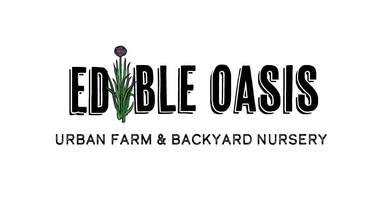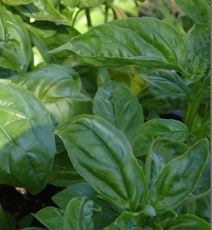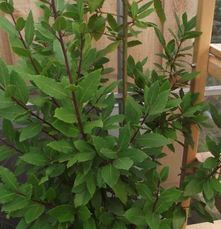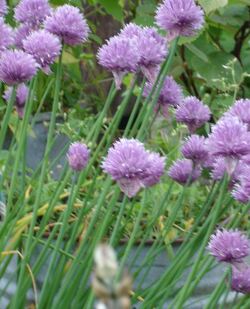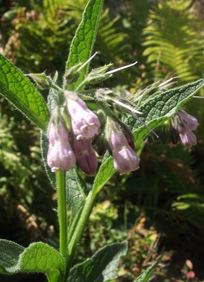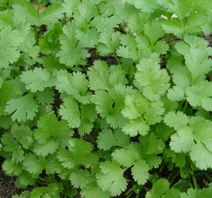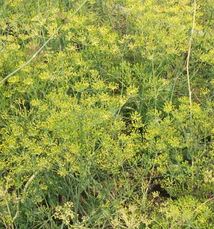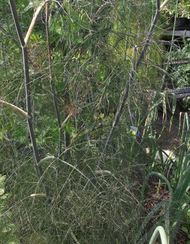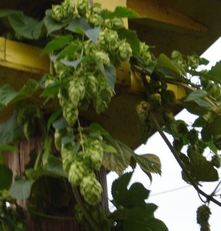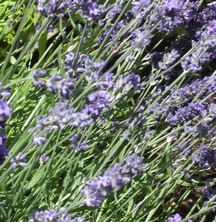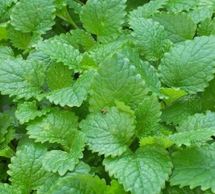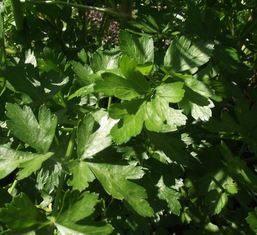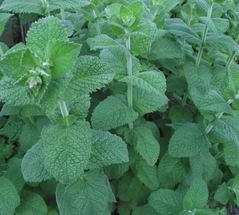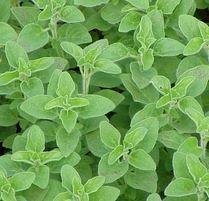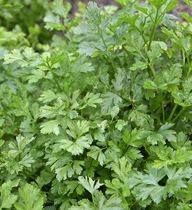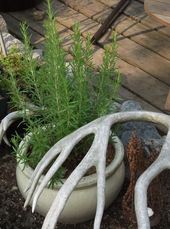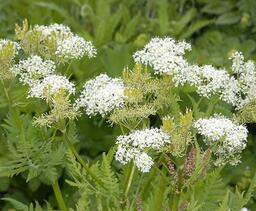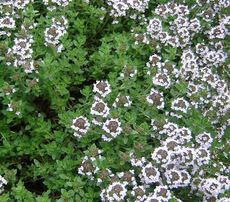Culinary and Medicinal Herbs (SCROLL DOWN TO SEE ENTIRE LIST)
|
Anise hyssop - Agastache foeniculum Attracts Pollinator / Medicinal Herb
The upright, clump-forming plants generally grow 2-3 feet tall and about 1-2 feet wide from a small tap root with spreading rhizomes. The aromatic leaves have a licorice-like (anise) scent and are used in herbal teas, to flavor jellies or eaten fresh in small quantities, such as in a salad with other greens. The dried leaves can be used in potpourri. Flower color varies from white to pale blue and lavender through blue-purple, with the color more intense at the tip. The flowers are attractive to pollinators – bees, particularly bumblebees, butterflies, beetles and other insects that feed on the nectar or pollen, as well as hummingbirds. |
|
Basil - Ocimum basil Culinary Herb / Attracts Pollinators
Popular in Mediterranean cooking and a favourite for home gardeners – fragrant flowers and foliage. A great addition to any tomato dish, salads and of course in pesto. Basil is a bushy annual herb with fragrant green leaves. Grows best in a warm location in moderately rich soil that is well draining. Avoid windy spots. For best flavour harvest before white flower heads form and pinch back to encourage new growth. Plant after risk of frost has past when night time temperatures are over 60 degrees. |
|
Bayleaf - Laurus nobilis Culinary Herb
Popular evergreen cooking herb – the dried leaf is used to flavour soups, stews and sauces. Leaf is used whole and removed prior to serving. Tender plant requires greenhouse or sun room to survive local winters. Plant in container (not terracotta) so you can move indoors for the cold winter months. Grow in the sunniest, warmest spot you have available. Likes moderately rich soil that drains well. Mulch to prevent drying out – water regularly. Fertilize lightly with compost tea in early spring and again mid summer. |
|
Chives - Allium schoenoprasum Culinary Herb / Attracts Pollinator
Chives are perhaps the easiest and most versatile herbs to grow. No matter how small your space you have rooms for chives – even if its just a pot on a sunny windowsill. Chives are part of the onion family and are perennial - producing beautiful edible purple flowers and tasty greens that can be added to any salad or stir fry, not to mention sprinkled atop baked potatoes. Grows easily in a variety of conditions but does best in a sunny spot soil that is rich in organic material and drains well. Once established, cut back as required and it will quickly rejuvenate. |
|
Comfrey- Symphytum officinale Attracts Pollinators / Medicinal Herb
This hardy perennial herb was once known for its many healing properties. It is now generally considered toxic to consume but still used today in external applications. Comfrey is an important and useful plant for the organic gardener. The plant has a deep tap root that absorbs an array of micro-nutrients that are released into the soil when the leaves are composted or made into teas. Its leaves have a high potassium content. Cut back any time – can harvest 2-3 time or more per year. Let some flowers form to feed the bees. A favourite of permaculturalists. Quite aggressive – best grown off on its own. Grows in a variety of conditions and soil types – not a vary picky plant. |
|
Cilantro / Coriander - Coriandrum sativum Culinary Herb
You get two for one with this great annual kitchen herb – frost tolerant and slow to bolt. Cilantro is the fresh greens which is used in a variety of Mexican dishes, coriander the dried seed used in curries. Grows best in full sun in well draining organic soil. Keep moist and cut back regularly to encourage fresh growth. |
|
Dill - Anethum graveolens Culinary Herb / Attracts Pollinators
Dill is a tall growing Biennial / Self seeding annual that produces both edible leaves and seeds. Deadhead through the summer if you want to use the leaves or let it grow out to collect seeds. Tolerates some drought once established but flourishes in rich organic well draining soil and a sunny locations. Great for salads, chicken and fish. Notorious pickling herb. |
|
Fennel - Foeniculum vulgare Culinary Herb / Attracts Pollinators
Tall growing hardy annual / self seeder adds height and texture to the garden. Soft feathery foliage. Attracts bees and lady bugs to the garden. Use fresh leaves in salads and fish dishes. Seeds can be harvested for use in cooking. Licorice flavoured. Tolerates a variety of soil conditions and even drought like conditions once established. Does best in full sun. Cut back at in fall and wait for fresh growth in the spring. |
|
Hops CASCADE - Humolus lupulus Brewing / Culinary Herb
Known famously as a the beer herb – hops is a hardy herbaceous perennial vine that once established can grow 15-20 feet in a year. Great ornamental value in the garden for creating shade or privacy. Tolerates a variety of soil conditions but does best with a fair amount of sun. Aggressive grower that is best grown in a container to prevent unwanted spreading. Produces tons of light pine cone like flowers that can be used in your own home brew. |
|
Lavender - Lavander angustifolia Medicinal Herb / Attracts Pollinators
Known for its therapeutic oils, Lavender is a somewhat tender perennial herb that grows as a shrub. Tolerates most winters in the lower mainland but can die off during harsh winters. Beautiful purple blue flowers with sweet fragrant flowers. Does best in full sun in well draining soil, poor drainage can lead to root rot. Grows in a variety of soils and does well in rocky hot locations. Great for container growing. Drought resistant once established. Prune back in the fall to protect from snow damage and maintain stronger plant. |
|
Lemon Balm - Melissa officinalis Culinary Herb
Popular perennial herb – great in herbal teas and as an air freshening addition to bouquets of flowers. Best to grow in a container because of its spreading habit. Does best in partial shade. Attracts bees and other beneficial insects. Cut back before flowers form seed to prevent spreading. |
|
Lovage - Levisticum officinale Culinary Herb
Tall growing hardy perennial herb, looks somewhat like a large overgrown celery and adds similar flavour to soups and stews. Use stalk or roots in broths and soups (remove before serving) or cut in fresh leafs. Produces whitish yellow flowers – seeds are sometimes used in cooking as a replacement for fennel seed. Cut right back to the ground in fall add fresh compost around plant in the spring to give it a head start. |
|
Mint - Mentha sp. Culinary Herb
Mojito anyone? Mint is a truly easy perennial herb to grow, all you need is a moderately sunny spot and rich soil. Keep moist for best production. Grow in a container as its aggressive rooting can become a nuisance if planted directly in the garden. Great in a variety of cold and warm drinks. |
|
Oregano - Origanum vulgare Culinary Herb / Attracts Pollinators
A staple of Italian cooking – shrubby perennial ground cover herb. Grows well in a variety of conditions but thrives in full sun – with well draining soil. Requires minimal watering. Flavour is strongest once buds have formed but before flowers open. Harvest throughout the season as needed, keep cut back to 12” to maintain best harvest. Can be harvested fresh for much of the year but can also easily be dried for future use. |
|
Parsley - Petroselinum Culinary Herb
So much more than just a garnish. Parsley cleans and re-freshens the pallet. Self seeding annual. Grows best full sun in well draining soil, rich in organic material. Available in curly and flat leafed varieties. Harvest outer leaves to stimulate fresh growth. Used in soups, stews and salads. |
|
Rosemary - Rosmarinus officinalis Culinary Herb
A must have for any herb garden. Rosemary is a wood evergreen perennial that produces fragrant pine like needles and flowers that vary from white, to pink to purple. Semi hardy – knock snow off branches in the winter to prevent damage and death. Grows well in containers. Plant in full sun in well draining soil – do not over water. Snip off throughout the year when needed. Perfect for roast potatoes, lamb and chicken. Use long pieces as skewers on the barbecue. |
|
|
Sage - Salvia officinalis Culinary Herb / Attracts Pollinators
Sage is a perennial, evergreen shrub with woody stems, grayish leaves, and blue to purplish flowers. Easy to grow in most soils with even minimum organic material - like full sun. Plant in well drained soil. Easy to maintain with late fall or early spring pruning. Sage us a culinary and medicinal herb. Great with pork, poultry and lamb. Use in your turkey stuffing. Aromatic and flavourful. |
|
Sweet cicely - Myrrhis odorata Medicinal Herb / Attracts Pollinator
An attractive, early-blooming perennial herb with delicate, fern-like foliage, clusters of tiny white flowers and a pleasant, anise-like aroma. Perform best in sun or part shade and moist, well-drained soil. Plants are rich in nectar and highly valuable to bees and other beneficial insects. Used to treat ailments such as stomachache and coughs, |
|
Thyme - Thymus sp. Culinary Herb / Attracts Pollinators
Low growing, shrubby perennial herb that produces pungent flavourful leaves and white (purple and pink) flowers in late spring, early summer. Great for edging your garden – some ornamental varieties are used for filling between stepping stones. Drought tolerant once established. Grows best in sunny location in average soil. Harvest by bunching and cutting back to 6”. In the kitchen use in tomato sauces, stews and soups – great with chicken. |
